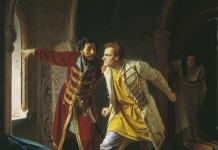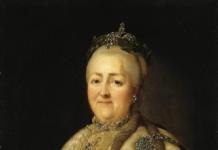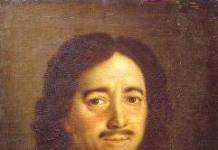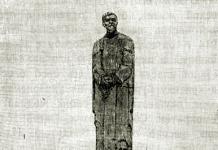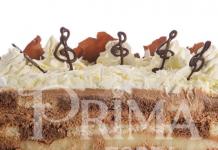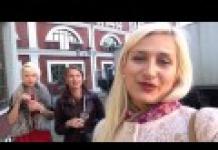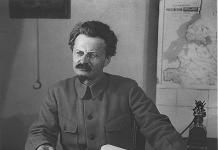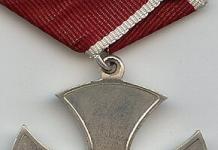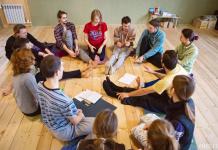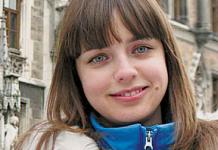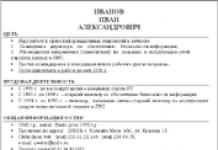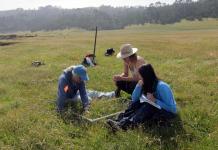The first years of the reign of Peter I.
Azov campaigns and the “Great Embassy”.
Industry.
Trade.
Agriculture.
Financial policy.
Reorganization of the public administration system.
The Church and the liquidation of the patriarchate.
Creation of a regular army and navy.
Streltsy uprising of 1698
“The Case of Tsarevich Alexei.”
Astrakhan uprising.
Uprising under the leadership of K. Bulavin.
The main directions of foreign policy in the era of Peter I and the Northern War.
Reforms in the field of education and culture.
The first years of the reign of Peter I.
After the August coup of 1689, power in the country passed to supporters of the seventeen-year-old Tsar Peter Alekseevich (who formally ruled until 1696 together with his brother Ivan) - P.K. Naryshkin, T.N. Streshnev, B.A. Golitsyn and others. A number of important government posts were also occupied by relatives of Peter’s first wife E.F. Lopukhina (the wedding took place in January 1689). Having given them the leadership of the country, the young tsar devoted all his energy to “Neptune and Mars fun”, for which he actively attracted “foreign servicemen” who lived in the German settlement (Kukue).
Peter surrounded himself with capable, energetic assistants and specialists, especially military ones. Among the foreigners, the following stood out: the tsar's closest friend F. Lefort, the experienced general P. Gordon, the talented engineer J. Bruce, and others. And among the Russians, a close-knit group of associates gradually formed, who subsequently made a brilliant political career: A.M. Golovin, G.I. Golovkin, brothers P.M. and F.M. Apraksin, A.D. Menshikov. With their help, Peter organized maneuvers of “amusing” troops (the future two guards regiments - Preobrazhensky and Semenovsky), which were held in the village of Preobrazhensky. Peter paid special attention to the development of the Russian navigator. Already in May 1692, his first “amusing” ship, built with the participation of the Tsar himself, was launched on Lake Pereslavl. In 1693-1694. The first Russian naval ship was built in Arkhangelsk and another one was ordered in Amsterdam. It was on board a Dutch-built ship in July 1694, during a real sea voyage organized by the Tsar, that the Russian red-blue-white flag was first raised.
Behind Peter’s “military amusements” there was a far-reaching goal: the struggle for Russia’s access to the sea. Due to the short winter navigation, the Arkhangelsk port could not provide year-round trade. Therefore, the bet was made on access to the Black Sea. Thus, Peter returned to the idea of the Crimean campaigns, in which Prince V.V. failed. Golitsyn. After a three-month siege of Azov (spring - summer 1695), Peter was forced to retreat. Without a fleet, it was impossible to besiege the fortress from both land and sea. The first Azov campaign ended in failure. In the winter of 1695/96. Preparations for the second campaign began. Construction of the first Russian fleet began in Voronezh. By spring, 2 ships, 23 galleys, 4 fire ships and 1,300 plows were ready, on which the 40,000-strong Russian army again besieged Azov in May 1696. After a blockade from the sea on July 19, the Turkish fortress surrendered. The fleet found a convenient harbor in Taganrog and began building a port. But still, the forces to fight Turkey and Crimea were clearly not enough. Peter ordered the construction of new ships (52 ships in 2 years) at the expense of landowners and merchants.
At the same time, it was necessary to start looking for allies in Europe. Thus was born the idea of the “Great Embassy” (March 1697-August 1698). Formally, it had the goal of visiting the capitals of a number of European states to conclude an alliance against Turkey. Admiral General F.Ya. was appointed as great ambassadors. Lefort, General F.A. Golovin, head of the Ambassadorial Prikaz, and Duma clerk P.B. Voznitsyn. The embassy included 280 people, including 35 volunteers who were traveling to learn crafts and military sciences, among whom, under the name of Peter Mikhailov, was Tsar Peter himself. The main task of the embassy was to familiarize itself with the political life of Europe, study foreign crafts, life, culture, military and other orders. During his one and a half year stay abroad, Peter and his embassy visited Courland, Brandenburg, Holland, England and Austria, met with sovereign princes and monarchs, studied shipbuilding and other crafts. Came in the summer of 1698. A message from Moscow about a new uprising of the archers forced the tsar to return to Russia.
International relations in Europe at this time were not in favor of continuing the war with Turkey, and soon (January 14, 1699), Russia, like other countries members of the “Holy League,” had to agree to a truce concluded in Karlovtsy. However, the “Great Embassy” became a true academy for Peter, and he used the experience gained in carrying out reforms in both domestic and foreign policy. For a long period, it determined the task of Russia’s struggle with Sweden for possession of the Baltic coast and access to the sea. Reorientation of Russian foreign policy by the beginning of the 18th century. from the southern direction to the northern coincided in time with enormous transformations that swept the country in all spheres of life, from priority diplomatic and military efforts to the Europeanization of life. Preparations for the war with Sweden served as an impetus for deep political and socio-economic reforms, which ultimately determined the appearance of the Peter the Great era. Some reforms took years, others were rushed. But on the whole, they formed a system of an extremely centralized absolutist state, headed by “an autocratic monarch who, as Peter himself wrote, should not give an answer to anyone in his affairs in his affairs.” The transformations were formalized by legislative decrees of the tsar, and their number in the first quarter of the 18th century. amounted to more than 2.5 thousand.
Industry.
During Peter’s accession, Russian industry, strictly speaking, did not exist and there was only one major merchant in Russia: the Tsar. During the duumvirate of Peter and John, a large reward was promised to the captain of a French ship for importing white paper, wine and some other goods into the country that were difficult to obtain in any other way. At the same time, the first Russian economist Pososhkov wrote a book - his “Testament”, where he proclaimed contempt for wealth. Twenty years later, the same author wrote, on white paper made in Russia, “A Discourse on Poverty and Wealth,” in which he tries to come up with ways to increase the wealth of the state and individuals and, before Smith and Turgot, explains the benefits of piecework over daily work. Peter did his job.
This is a very significant matter. Judging by the intensity of the efforts, the variety and ingenuity of the means used, the logical coherence of the guiding threads, despite some inconsistency, it deserves an honorable place in the history of the brilliant worker. To increase the well-being of individuals, while at the same time increasing state revenues, to simultaneously create new sources of taxation and new sources of production, to replace imported goods with products of domestic industry; to arouse the activity of the people and their spirit of enterprise; to force idle people, monks, nuns, and beggars to take places in the ranks of the working population; eliminate the indifference and even hostility of the administration towards the productive forces, introduce changes in unsatisfactory justice, eliminate the insufficient development of credit. lack of public safety, create a third estate, and finally introduce Russia into the modern economic movement.
The success of his enterprise was partly spoiled by an unfortunate coincidence and a fundamental mistake. Coincidentally, there was a war with its consequences and inevitable demands. She turned Peter, a staunch opponent of monopolies, into a creator of new monopolies, destroying with one hand what the other was doing. The mistake was his confidence in the ability to create a commercial and industrial life, to supply this creation with organs corresponding to its needs, to give it flesh and blood, then to control its movements, to turn it to the right and to the left, like regiments being created and commanded; by decrees and under the threat of the cane. Commercial and industrial companies made the first attempt of this kind in 1699. The Dutch were scared at first, but eventually they started laughing.
The war required money; the maintenance of standing troops gave impetus to the spirit of mercantilism in the West, and Peter is a zealous imitator of Colbert. True, Colbert also had no national covenants on his side. Already under Alexei Mikhailovich, perhaps even earlier, the right to import was paid for at Russian customs in Hungarian chervonets or Dutch thalers. Peter preserved, strengthening it, this system, which has survived to this day. He prohibited the export of precious metals, ignoring the warnings of Baudin and Childe about the dangers of such a practice. Having never read Klok, Schroeder or Decker, Pegr went further than them, forbidding his subjects to accept domestic coin as payment for their goods. According to Marperger, around 1723 Russia earned several barrels of gold annually in exchange with foreign countries. Peter also believed in the benefits of protectionism. The ruler of the country, which to this day has remained almost exclusively, in the sense of foreign trade, a producer of raw products, prohibited the export of some of these products, for example, flax, and so limited the right to export the rest that it was almost a prohibition. In anticipation of the opportunity to dress the entire army in locally produced cloth, he himself did not recognize otherwise for his dress and made it mandatory for liveries. When a Frenchman named Mamoron founded a stocking factory in Moscow, Muscovites were forbidden to buy them anywhere else. The industrialists, who were under the patronage of the tsar, hesitated to use the felt they produced for hats; a decree appeared that gave them courage: they were allowed to sell their goods only by releasing a certain number of hats of their production onto the market.
Such persistence of convictions, such an abundance of incentive and coercive measures, moral and monetary support, gradually did their job. Factories arose, some subsidized, others operated directly by the sovereign, others, finally, existing with their own funds. The Empress maintained a tulle factory and a starch factory in Yekateringof. Peter, who at first limited his activity to the production of items related to navigation: sailing cloth, saltpeter, sulfur, leather, weapons, gradually and partly against his will, also expanded its scope. We see him as a manufacturer of Kolomyanka in St. Petersburg, paper in Dudergof, cloth almost everywhere.
Unfortunately, all these institutions were far from thriving. It was in vain that the sovereign sold the Kolomyanka at a loss, giving five kopecks for an arshin of material that cost him fifteen. But, as usual, he continued to persist, even expanding the business, trying to introduce the production of luxury goods to his state. Russia produced carpets and tapestries without even having a paper spinning factory! And as always, the king did not limit himself to impulse, he struck from the shoulder. In 1718 The decree prescribed the use of lard instead of tar when processing yuft. A period of two years was given “to learn this, after which, if anyone makes yufti as before, he will be sent to hard labor and deprived of all his property.”
But, thus scattering himself in all directions, Peter finally stumbled upon grateful, directly productive, inexhaustibly rich soil, and immediately his impetuosity, ardor, and creative passion began to work miracles. He took up the mines. Already under Alexei Mikhailovich, the Dutch and the Dane mined ore and built factories in the vicinity of Moscow and cast cannons. With Peter's intervention, the matter assumed enormous proportions. Having ordered the establishment of ironworks in Verkhoture and Tobolsk by decree in 1697, the tsar had exclusively military purposes in mind: he needed cannons and rifles; but once it started, it went further and further, and the modern widespread development of the Russian mining industry owes its origin to it.
The sovereign began with the mining and processing of iron ore; , later he was seized by gold fever. He became even more interested, collecting all the instructions, exploring all the paths. True, numerous expeditions organized by him, Bekovich-Cherkassky to Persia in 1717, Likharev to Siberia in 1719, remained without results. Until 1720, the only silver mines were opened. But along the way, copper was found, again iron and, in 1722, coal. Thirty-six foundries were established in the Kazan province and thirty-nine in the Moscow province.
Private initiative - with the exception of the isolated case of Demidov - remained inactive for a long time. A decree issued in 1719 gives characteristic instructions in this regard: it declares the exploration and extraction of all kinds of metals on all lands without distinction free and accessible to the public. Owners of ore-bearing lands have only the right of primacy. So much the worse for them if they are slow to use it. “If they cannot or do not want it, then the right to build factories is given to others, with the payment to the landowner of 32 shares of the profit, so that God’s blessing does not remain underground in tuna.” Anyone who conceals ore or interferes with its mining is subject to corporal punishment and the death penalty. In 1723 the legislator took another step; he intended to finally end the system of the crown industrial monopoly. To the charter developed by the Manufactory Collegium, he added a manifesto inviting private individuals to replace the state in the operation of institutions of all kinds created by it, offering favorable conditions. And such versatile, persistent efforts did not remain fruitless; the creative movement of life grew, expanded, and domestic industry became a reality.
Trade.
The history of trade under Peter is almost entirely the history of domestic trade. Upon his accession to the throne, Peter had a strong desire to renounce his royal rights, which turned him into the largest and even the only major merchant of the state. But he had to submit to the law of war: he remained a merchant in order to earn money, and, without doing anything halfway, he increased the number of his affairs, monopolizing more than before, completely absorbing the entire domestic and foreign market. By creating new branches of trade, he only increased the list of monopolies. A wholesale buyer, a petty trader, he even sold Hungarian wine in Moscow! At one time, absorbed in the concerns of management and disappointed by the uncertainty of the income derived from trading enterprises, he decided to farm out the latter. Menshikov took Arkhangelsk fishing, blubber and seal skins. Then the hope for a near peace reduced the sovereign’s financial difficulties, and he returned to his natural, liberal aspirations. In 1717, trade in bread was declared free, and in 1719 all monopolies were destroyed. At the same time, the Trade Collegium, which had existed since 1715, began to show fruitful activity, engaging, among other things, in the commercial education of the trading class, sending dozens abroad, to Holland and Italy, of young people chosen from among the sons of large Moscow merchants, whose number was rapidly growing. increased. The sovereign's diplomacy, in turn, worked to expand international relations. The war had previously led to unfortunate compromises in this regard, for example, to the sale of emergency rights and privileges to the city of Lübeck in 1713 for thirty-odd thousand thalers, and to similar conditions with Danzig and Hamburg. Since 1717, Peter resolutely sought to put an end to these errors, and in the negotiations begun at that time with France, he no longer touched on such an issue, just as in the instructions given to the consulates established simultaneously in Toulon, Lisbon and London. Sometimes Peter still succumbed to the temptation to control rather arbitrarily the destinies of these nascent relations. Proof of this is the history of the St. Petersburg port, as well as the formal battles of the great man with foreign and Russian merchants who stubbornly preferred the Arkhangelsk port. When the king exhausted the means of peaceful persuasion; when he saw that neither the creation of the vast Gostiny Dvor, nor the special magistracy, composed mostly of foreigners, nor the efforts he spent to concentrate their favorite product, hemp, in his new capital, at cheap prices and in abundance, could attract them there , he resolutely resorted to the behests of his ancestors. He did not directly forcibly transport the Arkhangelsk residents to St. Petersburg, as Grand Duke Vasily did with the Pskovites, relocating them to Moscow; but he ordered the Arkhangelsk people from now on to buy or sell hemp no other way than in St. Petersburg.
The measure bore fruits that were to be expected. The new capital was still a disgusting warehouse. The canal system intended to connect the Volga with the Neva via Lake Ladoga was still in the project. The eminent English engineer Perry, who was entrusted with the execution of the work, dissatisfied with the ill-treatment he had to endure, abandoned it at the very beginning. The second canal, invented by Peter to avoid dangerous navigation on Lake Ladoga, remained unfinished until 1732. The third system, based on the use of connecting rivers, served only to enrich the miller Serdyukov, who offered and took advantage of the concession granted to him too hastily to build up the banks of the Una and Shlina mills and taverns that had nothing to do with the St. Petersburg port. Therefore, hemp, leather and other goods, since since 1717 two-thirds of all products were necessarily sent to St. Petersburg, were delivered with great difficulty, burdened with enormous transportation costs, and not finding buyers here, they were piled up in heaps, devalued due to the large accumulation, and finally spoiled, especially hemp.
By good or by force, Petersburg was to become a trading port. In 1714, only sixteen foreign ships arrived there, a year later fifty, one hundred nineteen in 1722, one hundred eighty in 1724. Peter laid the foundation for a system of water communications, which his successors, including Catherine II, tried to complete and improve, and which, connecting the Volga basin with the Neva and Dvina basins, i.e. the Caspian Sea with the Baltic and White Seas, contained in the space occupied by canals three hundred and two miles, seventy-six lakes and one hundred and six rivers. Here there was an enormous expenditure of wealth, labor and even human lives; but the strength of Russia and the secret of its fate have always, for the most part, consisted in the desire and ability not to think about sacrifices in order to achieve the intended goal. Long-suffering men, tens of thousands buried in the Finnish swamps, and this time they submitted rather resignedly.
Peter did not attach the same importance to the development of land communications, and did not pay any attention to them. He didn't build roads. This is still one of the weak points of Russia from an economic point of view, and the insufficient number of existing highways is solely the work of the engineers of the Institute of Railways, founded only in 1809. However, the great man treated with due care the caravan trade organized by his ancestors. He dealt with it himself, purchasing Tokaji grapes from Hungary; transporting the wine obtained from it to Moscow on hundreds of carts and sending the products of Siberia back to Hungary. While directing the greatest effort to the Baltic Sea and the west, he did not lose sight of his southeastern border and the commercial interests that required his intervention. It is possible that having reached Bukhara, he would subsequently establish trade with India. Separate caravans were already arriving in Astrakhan, bringing not only silk and paper fabrics produced in Bukhara, but also goods from India: precious stones, gold and silver items. In any case, Peter managed to take possession first of the course of the Irtysh, the possession of which protected the borders of Siberia from the Kalmyks and Kyrgyz, then of the Kolyvan Mountains, where treasures discovered later fulfilled the Greek fairy tale about gold mines guarded by gnomes. Having held out in Azov, Peter would also have continued, and perhaps would have achieved, the restoration of the ancient trade route of the Venetians and Genoese. Thrown back to the Caspian Sea, he, of course, made an attempt to move this route, directing it from Astrakhan to St. Petersburg. The great expedition of 1722, proposed, and the beginning of the foundation of a large city - a storage point - at the mouth of the Kura, where five thousand people of Tatars, Cheremis, Chuvash worked at the moment of the tsar’s death, apparently indicate the existence of such a thought. We can say that the plan was partly fantastic, even crazy, and there was absolutely no calculation of possibilities, distances, or transportation costs. But despite the disproportionate daring of the enterprise and the oblivion to which its immediate successors betrayed it, a certain result was achieved: the intended path to the markets of Persia and India forms part of the heritage, the colossal asset of which Russia continues to enjoy at the present time.
Agriculture.
Such a versatile, almost all-encompassing person could not help but be a farmer. And indeed, he was, and even passionate. In the history of Russian agriculture, the reign of Peter also constitutes an era. He was not content with teaching his peasants how to plant potatoes, as Frederick later did; With a sickle in his hands, he showed peasants near Moscow how to harvest grain; near St. Petersburg, how to weave bast shoes. He considered the peasants as students, and himself as a teacher, forbade them to wear soles lined with large nails, because this would spoil the floors, and determined the width of the rough canvas they wove on their hips. Having admired the garden of a rural priest in France, he immediately upon returning to Russia scolded his clergy: “Why don’t they start such gardens in their own country”! He was concerned with the selection of seeds for sowing, the raising of livestock, the fertilization of fields, and the use of implements and methods of improved farming; tried to grow grapes on the land of the Don Cossacks and took care of its more successful culture in the vicinity of Derbent, where he ordered to try Persian and Hungarian vines. In 1712 he established the first horse breeding farms; in 1706, the first herds of sheep were established in the present-day provinces of Kharkov, Poltava and Yekaterinoslav, where sheep are currently bred in huge numbers. Peter was also the first forester of his homeland. He was the first to defend the forests against the prevailing reckless destruction. To achieve this, however, he used methods that are hardly applicable at the present time even in Russia: along the banks of the Neva and the Gulf of Finland, at intervals of five miles, gallows were erected to edify the devastators. Even within the boundaries of present-day St. Petersburg, in the place now occupied by customs, there was a spruce forest then. Since the logging in it did not stop, Peter ordered a raid, hanged every tenth of the disobedient people caught and punished the rest with a whip. In general, on the basis of economic progress, the desire of the reformer encountered a double obstacle: a moral and a political one. Marked March 13, 1706, the decree addressed to the Senate punished with death local merchants who, following the habit they had acquired, about which their English customers strongly complained, mixed spoiled fiber or even stones into bales of hemp to increase weight. Raising the moral standard of commerce and industry nevertheless remained a task bequeathed to the future. At the end of the reign, the elements of commercial and industrial activity, created, called almost out of oblivion by the great creator, were still in a wild state. In 1722, Bestuzhev reported from Stockholm about the arrival there of several Russian merchants from Abo and Verel: “They brought a small amount of rough canvas, wooden spoons, nuts, and sell these goods along the streets in layers, cooking porridge for themselves in the open air; refuse to obey the demands of the police, get drunk, quarrel, fight and present a shameful spectacle of disgusting uncleanliness.”
Financial policy.
The political obstacle was finance. In the history of the great reign, financial policy is a dark spot. Of all the branches of Peter's creation, this branch, apparently, was most directly inspired and caused by the war, which was reflected in it. First of all, it does not have a transformative character at all; besides, she is almost always frank and disgusting.
The funds that Peter had at his accession to the throne cannot be put in direct parallel with the funds of other European states. According to Golikov, they did not exceed 1,750,000 rubles. Based on such a meager budget, the material existence of the Russian state would have taken on - even touching only the internal side, regardless of any efforts directed beyond its borders - the appearance of an insoluble riddle, if one did not take into account the very special conditions in which it then found itself. First of all, apart from maintaining the army, the state itself had almost no obligations. It did not pay its employees: they were obliged to serve it in return for the privileges it distributed, or they received their salaries indirectly, through “feeding”. It did not support roads, which did not exist then, and so on. Here, for example, is the expenditure budget of 1710. It is very instructive in this regard.
artillery........................ 221,799 rub.
fleet................................... 444,288 rub.
garrisons........................ 977,896 rub.
Recruitment costs................................... 30,000 rub.
purchase of weapons......................... 84,104 rub.
Other expenses (including salary
for feldzeichmisters .................................... 675,775 rub.
Before the accession of Peter in 1679, a very important beneficial measure was taken in this primitive organization, namely, the centralization of income into the Order of the Great Treasury, which was replaced in 1699 by the town hall. The great man, with his intervention, only destroyed everything that had been done. He was too pressed for time to follow a program that promised to give satisfactory results only over a long period of time. Needing big money immediately, he acted like the confused sons of rich parents. Instead of continuing to centralize and thus gradually destroy the individual in monetary terms). At the same time, high customs tariffs (up to 40% in foreign currency) reliably protected the domestic market. The growth of industrial production was accompanied by increased feudal exploitation, the widespread use of forced labor in factories: the use of serfs, purchased (possession) peasants, as well as the labor of the state (black-growing) peasantry, which was assigned to the plant as a constant source of labor. The decree of January 18, 1721 and subsequent laws (for example, of May 28, 1723) allowed private manufacturers to buy entire villages of peasants “without restrictions, so that those villages would always be inseparable from those factories.”
The history of Russia is diverse and interesting. Peter 1 was able to have a huge influence on her. In his reform activities, he relied on the experience of Western countries, but acted based on the needs of Russia, while not having a specific system and program for reform. The first Russian emperor was able to lead the country out of the “troubled” times into the progressive European world, forced him to respect the power and reckon with it. Of course, he was a key figure in the formation of the state.
Politics and government
Let's take a brief look at the policies and reign of Peter 1. He was able to create all the necessary conditions for wide acquaintance with Western civilization, and the process of abandoning the old foundations was quite painful for Rus'. An important feature of the reforms was that they affected all social strata; this made the history of the reign of Peter 1 very different from the activities of his predecessors.
But in general, Peter’s policy was aimed at strengthening the country and introducing it to culture. True, he often acted from a position of strength, nevertheless, he was able to create a powerful country, headed by an emperor with absolute unlimited power.
Before Peter 1, Russia was far behind other countries economically and technically, but conquests and transformations in all spheres of life led to the strengthening, expansion of the borders of the empire and its development.
The policy of Peter 1 was to overcome the crisis of traditionalism through many reforms, as a result of which modernized Russia became one of the main participants in international political games. She actively lobbied for her interests. Her authority grew significantly, and Peter himself began to be considered an example of a great reformer.
He laid the foundations of Russian culture and created an effective management system that lasted for many years.
Many experts, studying Russian history, believe that carrying out reforms by forceful imposition was unacceptable, although the opinion is not denied that otherwise the country simply could not be raised, and the emperor must be tough. Despite the reconstruction, the country did not get rid of the serfdom system. On the contrary, the economy rested on it, the stable army consisted of peasants. This was the main contradiction in Peter’s reforms, and this is how the preconditions for a crisis in the future appeared.
Biography
Peter 1 (1672-1725) was the youngest son in the marriage of Romanov A.M. and Naryshkina N.K. Learning the alphabet began on March 12, 1677, when he was not yet five years old. Peter 1, whose biography was full of bright events since childhood, later became a great emperor.
The prince studied very willingly, loved different stories and reading books. When the queen found out about this, she ordered history books from the palace library to be given to him.
In 1676, Peter 1, whose biography at that time was marked by the death of his father, was left to be raised by his older brother. He was appointed heir, but due to poor health, ten-year-old Peter was proclaimed sovereign. The Miloslavskys did not want to come to terms with this, and therefore the Streletsky rebellion was provoked, after which both Peter and Ivan were on the throne.

Peter and his mother lived in Izmailovo, the ancestral estate of the Romanovs, or in the village of Preobrazhenskoye. The prince never received a church or secular education; he existed on his own. Energetic, very active, he often played out battles with his peers.
In the German settlement he met his first love and made many friends. The beginning of the reign of Peter 1 was marked by a revolt, which was organized by Sophia, trying to get rid of her brother. She did not want to give power into his hands. In 1689, the prince had to take refuge in the regiments and most of the court, and his sister Sophia was removed from the board and forcibly imprisoned in a monastery.
Peter 1 established himself on the throne. From that moment on, his biography became even more eventful both in his personal life and in state activities. He took part in campaigns against Turkey, traveled as a volunteer to Europe, where he took a course in artillery science, studied shipbuilding in England, and made many reforms in Russia. He was married twice and had 14 officially recognized children.
Personal life of Peter I
She became the tsar's first wife, with whom they married in 1689. The bride was chosen by the great sovereign’s mother, and he did not feel tenderness for her, but only hostility. In 1698, she was forcibly tonsured a nun. Personal life is a separate page of the book, in which the story of Peter 1 could be described. On his way he met Martha, a Livonian beauty who was captured by the Russians, and the sovereign, seeing her in Menshikov’s house, no longer wanted to part with her. After their wedding, she became Empress Catherine I.

Peter loved her very much, she bore him many children, but after learning about her betrayal, he decided not to bequeath the throne to his wife. The king had a difficult relationship with his son from his first marriage. The emperor died without leaving a will.
Hobbies of Peter I
Even as a child, the future great Tsar Peter 1 assembled “amusing” regiments from his peers and launched battles. In later life, it was these well-trained regiments that became the main guard. Peter was very inquisitive by nature, and therefore he was interested in many crafts and sciences. The fleet is another of his passions; he was seriously involved in shipbuilding. He mastered fencing, horse riding, pyrotechnics, and many other sciences.
Beginning of reign
The beginning of the reign of Peter 1 was a dual kingdom, as he shared power with his brother Ivan. After the deposition of his sister Sophia, Peter did not rule the state for the first time. Already at the age of 22, the young king turned his attention to the throne, and all his hobbies began to take on real shape for the country. His first Azov campaign was undertaken in 1695, and the second in the spring of 1696. Then the sovereign begins to build a fleet.
Appearance of Peter I
From infancy, Peter was a rather large baby. Even as a child, he was handsome in both face and figure, and among his peers he was taller than everyone else. In moments of excitement and anger, the king’s face twitched nervously, and this frightened those around him. Duke Saint-Simon gave his exact description: “Tsar Peter 1 is tall, well-built, a little thin. Round face and beautifully shaped eyebrows. The nose is a little short, but not conspicuous, large lips, dark skin. The king has beautifully shaped black eyes, lively and very penetrating. The look is very welcoming and majestic.”

era
The era of Peter 1 is of great interest, since this is the beginning of the growth and comprehensive development of Russia, its transformation into a great power. Thanks to the transformations of the monarch and his activities, over several decades, a system of administration and education was built, a regular army and navy were formed. Industrial enterprises grew, crafts and trades developed, and domestic and foreign trade improved. There was a constant provision of jobs for the country's population.
Culture in Russia under Peter I
Russia changed greatly when Peter ascended the throne. The reforms he carried out were of great importance for the country. Russia became stronger and constantly expanded its borders. It became a European state that other countries had to reckon with. Not only military affairs and trade developed, but there were also cultural achievements. The New Year began to count from January 1, a ban on beards appeared, the first Russian newspaper and foreign books in translation were published. Career growth without education has become impossible.
Having ascended the throne, the great emperor made many changes, and the history of the reign of Peter 1 is diverse and majestic. One of the most important decrees stated that the custom of transferring the throne to descendants only through the male line was abolished, and any heir could be appointed at the will of the king. The decree was very unusual, and it had to be justified and the consent of the subjects sought, forcing it to be sworn. But death did not give him the opportunity to bring it to life.
Etiquette in the time of Peter
Significant changes occurred during the time of Peter 1 in etiquette. The courtiers wore European clothes; a beard could only be preserved by paying a large fine. It has become fashionable to wear Western-style wigs. Women who had not previously been present at palace receptions now became obligatory guests at them, their education improved, since it was believed that a girl should be able to dance, know foreign languages and play musical instruments.

Character of Peter I
The monarch's character was controversial. Peter is hot-tempered and at the same time cold-blooded, wasteful and stingy, tough and merciful, very demanding and often condescending, rude and at the same time gentle. This is how those who knew him describe him. But at the same time, the great emperor was an integral person, his life was completely devoted to serving the state, and it was to him that he devoted his life.
Peter 1 was very thrifty when he spent money on personal needs, but he did not skimp on the construction of his palaces and his beloved wife. The emperor believed that the easiest way to reduce vices was to reduce his needs, and he should set an example for his subjects. Here two of his incarnations are clearly visible: one - the great and powerful emperor, whose palace in Peterhof is not inferior to Versailles, the other - a thrifty owner, setting an example of economical life for his subjects. Stinginess and prudence were also evident to European residents.
Reforms
The beginning of the reign of Peter 1 was marked by many reforms, mainly related to military affairs, which were often carried out by force and did not always lead to the result he needed. But after 1715 they became more systematic. We touched upon reforms from the first years, which turned out to be ineffective in governing the country. If we consider the reign of Peter 1 briefly, we can highlight several important points. He organized the Near Office. Many collegiums were introduced, each responsible for its own area (taxes, foreign policy, trade, courts, etc.). has undergone radical changes. The position of fiscal officer was introduced to supervise employees. The reforms affected all aspects of life: military, church, financial, trade, autocratic. Thanks to a radical restructuring of all spheres of life, Russia began to be considered a great power, which is what Peter 1 sought.

Peter I: important years
If we consider important dates in the life and activities of the monarch, then Peter 1, whose years were marked by various events, was most active in some time periods:

The beginning of the reign of Peter 1 was from the very beginning built on the struggle for the state. It was not for nothing that they called him the Great. Dates of the reign of Peter 1: 1682-1725. Being strong-willed, decisive, talented, sparing neither effort nor time to achieve the goal, the tsar was strict with everyone, but first of all with himself. Often ruthless, but it was thanks to his energy, determination, assertiveness and some cruelty that Russia changed dramatically, becoming a Great Power. The era of Peter 1 changed the face of the state for many centuries. And the city he founded became the capital of the empire for 300 years. And now St. Petersburg is one of the most beautiful cities in Russia and proudly bears its name in honor of the great founder.
Peter I the Great (real name - Romanov Peter Alekseevich) - Russian Tsar, since 1721 - Emperor, an outstanding statesman, famous for a large number of cardinal reforms, commander - was born on June 9 (May 30, O.S.) in 1672 in Moscow; his father was Tsar Alexei Mikhailovich, his mother was Natalya Kirillovna Naryshkina.
The future emperor did not receive a systematic education, and although it is reported that his education began in 1677, in fact the boy was left largely to his own devices, spending most of his time with his peers in entertainment, in which he participated quite willingly. Until the age of 10, after the death of his father in 1676, Peter grew up under the supervision of Fyodor Alekseevich, his older brother. After his death, Ivan Alekseevich was supposed to become the heir to the throne, but the latter’s poor health contributed to the nomination of Peter to this post. Nevertheless, as a result of the Streltsy revolt, a political compromise was the enthronement of Peter and Ivan; Sofya Alekseevna, their elder sister, was appointed ruler.
During the period of Sophia's regency, Peter participated in government administration only formally, attending ceremonial events. Sophia, watching the grown-up Peter, who was seriously interested in military amusements, took measures to strengthen her power. In August 1689, Peter's supporters convened a noble militia, dealt with Sophia's main supporters, she herself was placed in a monastery, and after that power actually passed into the hands of Peter's party, Ivan remained only a nominal ruler.
Nevertheless, even after gaining real power, it was actually his mother and other close people who ruled instead of Peter. At first, after the death of Natalya Kirillovna in 1694, the state machine worked by inertia, so Peter, although he was forced to govern the country, entrusted this mission mainly to the ministers. He had become accustomed to detachment from affairs over many years of forced isolation from power.
At that time, Russia was very far from advanced European states in its socio-economic development. Peter's inquisitiveness, his ebullient energy, and keen interest in everything new allowed him to take on the most important issues in the life of the country, especially since life itself urgently pushed him towards this. The first victory in the biography of young Peter as a ruler was the second campaign against Azov in 1696, and this greatly contributed to the strengthening of his authority as a sovereign.
In 1697, Peter and his entourage went abroad, living in Holland, Saxony, England, Venice, Austria, where he became acquainted with the achievements of these countries in the field of technology, shipbuilding, as well as with the way of life of other countries of the continent, their political and social structure. The news of the Streltsy revolt that broke out in his homeland forced him to return to his homeland, where he suppressed the act of disobedience with extreme cruelty.
During his stay abroad, the tsar’s program in political life was formed. In the state, he saw the common good, which everyone, first of all, himself, had to serve, and set an example for others. Peter behaved in many ways unconventionally for a monarch, destroying his sacred image that had developed over the centuries, so a certain part of society was critical of him and his activities. Nevertheless, Peter I led the country along the path of radical reforms in all areas of life, from public administration to culture. They began with an order to shave their beards and wear clothes in a foreign style.
A number of reforms were undertaken in the public administration system. Thus, under Peter I, the Senate and collegiums were created; he subordinated the church to the state and introduced an administrative-territorial division of the country into provinces. In 1703, at the mouth of the Neva River, he founded the new Russian capital - St. Petersburg. They assigned a special mission to this city - it was to become a model city, a “paradise”. During the same period, instead of the boyar duma, a council of ministers appeared, and a lot of new institutions arose in St. Petersburg. When the Northern War ended, Russia received the status of an empire in 1721, and Peter was named “Great” and “Father of the Fatherland” by the Senate.
Much had changed in the economic system, since Peter was well aware of how deep the gulf was between the country he led and Europe. He took many measures to develop industry and trade, including foreign trade; under him, a large number of new industrial sectors, factories and factories, manufactories, shipyards, and marinas appeared. All this was created taking into account the adopted Western European experience.
Peter I was credited with creating a regular army and navy. The foreign policy pursued by him was extremely energetic; Peter the Great undertook many military campaigns. In particular, as a result of the Northern War (1700-1721), territories that Sweden had conquered earlier were annexed to Russia; after the war with Turkey, Russia received Azov.
During the reign of Peter, Russian culture was replenished with a large number of European elements. At this time, the Academy of Sciences was opened, many secular educational institutions were opened, and the first Russian newspaper appeared. Through the efforts of Peter, the career advancement of the noble class was made dependent on the level of their education. Under Peter I, the civil alphabet was adopted and New Year celebrations were introduced. A fundamentally new urban environment was being formed in St. Petersburg, starting with previously unbuilt architectural structures and ending with the forms of people’s pastime (in particular, Peter introduced the so-called assemblies by decree).
Peter I is credited with bringing Russia onto the international stage as a great power. The country has become a full-fledged participant in international relations, its foreign policy has become active and led to the strengthening of its authority in the world. For many, the Russian emperor himself turned into an exemplary reformer sovereign. For a long time, the management system he introduced and the principles of the territorial division of Russia were preserved; they laid the foundations of national culture. At the same time, Peter's reforms were contradictory, which created the preconditions for a crisis to brew. The ambiguity of the course he pursues is associated with violence as the main instrument of reform, the lack of changes in the social sphere, and the strengthening of the institution of serfdom.
Peter I the Great left behind an extensive manuscript heritage, numbering more than a dozen volumes; the emperor's relatives, acquaintances, his contemporaries, and biographers recorded many of the sovereign's statements that have survived to our time. On February 8 (January 28, O.S.), 1725, Peter I died in his brainchild, St. Petersburg. It is known that he suffered from a number of serious illnesses, which significantly brought his death closer.
Date of publication or update 12/15/2017
Peter I Alekseevich the Great
Years of life: 1672-1725
Reign: 1689-1725
Russian Tsar (1682). The first Russian emperor (since 1721), an outstanding statesman, diplomat and commander, all his activities were related to reforms.
From the Romanov dynasty.
In the 1680s. under the leadership of the Dutchman F. Timmerman and the Russian master R. Kartsev Peter I studied shipbuilding, and in 1684 he sailed on his boat along the Yauza River, and later along Lake Pereyaslavl, where he founded the first shipyard for the construction of ships.
On January 27, 1689, Peter, by order of his mother, married Evdokia Lopukhina, the daughter of a Moscow boyar. But the newlyweds spent time with friends in the German settlement. There, in 1691, he met the daughter of a German artisan, Anna Mons, who became his lover. But according to Russian custom, having married, he was considered an adult and could lay claim to independent rule.
But Princess Sophia did not want to lose power and organized a revolt of the archers against Peter. Having learned about this, Peter hid in the Trinity-Sergius Lavra. Remembering how the archers killed many of his relatives, he experienced real horror. From that time on, Peter developed nervous tics and convulsions.
Peter I, Emperor of All Russia. Engraving from the early 19th century.
But soon Petr Alekseevich came to his senses and brutally suppressed the uprising. In September 1689, Princess Sophia was exiled to the Novodevichy Convent, and her supporters were executed. In 1689, having removed his sister from power, Pyotr Alekseevich became the de facto king. After the death of his mother in 1695, and in 1696 of his brother-co-ruler Ivan V, on January 29, 1696, he became an autocrat, the sole king of all Rus' and legally.
Peter I, Emperor of All Russia. Portrait. Unknown artist of the late 18th century.
Having barely established himself on the throne, Peter I personally participated in the Azov campaigns against Turkey (1695–1696), which ended with the capture of Azov and access to the shores of the Sea of Azov. Thus, Russia's first access to the southern seas was opened.
Under the guise of studying maritime affairs and shipbuilding, Peter volunteered at the Great Embassy in 1697–1698. to Europe. There, under the name of Peter Mikhailov, the tsar completed a full course of artillery sciences in Brandenburg and Koenigsberg, worked as a carpenter in the shipyards of Amsterdam, studied naval architecture and plan drawing, and completed a theoretical course in shipbuilding in England. On his orders, instruments, weapons, and books were purchased in England, and foreign craftsmen and scientists were invited. The British said about Peter that there was no craft that the Russian Tsar would not have become familiar with.
Portrait Peter I. Artist A. Antropov. 1767
At the same time, the Grand Embassy prepared the creation of the Northern Alliance against Sweden, which finally took shape only 2 years later (1699). Summer 1697 Peter I held negotiations with the Austrian emperor, but having received news of the impending uprising of the Streltsy, which was organized by Princess Sophia, who promised many privileges in the event of the overthrow of Peter, he returned to Russia. On August 26, 1698, the investigation into the Streltsy case did not spare any of the rebels (1,182 people were executed, Sophia and her sister Martha were tonsured as nuns).

Returning to Russia, Peter I began his transformative activities.
In February 1699, on his orders, the unreliable rifle regiments were disbanded and the formation of regular soldiers and dragoons began. Soon, decrees were signed, ordering men to “cut their beards,” wear European-style clothing, and women to uncover their hair, under pain of fines and flogging. Since 1700, a new calendar was introduced with the beginning of the year on January 1 (instead of September 1) and chronology from the “Nativity of Christ”. All these actions Peter I provided for the breaking of ancient mores.

At the same time Peter I began serious changes in government. country. Over the course of more than 35 years of rule, he managed to carry out many reforms in the field of culture and education. Thus, the monopoly of the clergy on education was eliminated, and secular schools were opened. Under Peter, the School of Mathematical and Navigational Sciences (1701), the Medical-Surgical School (1707) - the future Military Medical Academy, the Naval Academy (1715), the Engineering and Artillery Schools (1719), and translator schools were opened. at the collegiums. In 1719, the first museum in Russian history began to operate - the Kunstkamera with a public library.

Monument to Peter the Great near the House of Peter the Great in St. Petersburg.
ABC books and educational maps were published, and a systematic study of the country's geography and cartography began. The spread of literacy was facilitated by the reform of the alphabet (cursive was replaced by civil script, 1708), and the publication of the first Russian printed newspaper Vedomosti (from 1703). In the era Peter I many buildings for state and cultural institutions, the architectural ensemble of Peterhof (Petrodvorets) were erected.
However, reform activities Peter I took place in a bitter struggle with the conservative opposition. The reforms provoked resistance from the boyars and clergy (conspiracy of I. Tsikler, 1697).

In 1700 Peter I concluded the Peace of Constantinople with Turkey and began a war with Sweden in alliance with Poland and Denmark. Peter's opponent was the 18-year-old Swedish king Charles XII. In November 1700 they first encountered Peter near Narva. The troops of Charles XII won this battle, since Russia did not yet have a strong army. But Peter learned a lesson from this defeat and actively began strengthening the Russian armed forces. Already in 1702, all the lands along the Niva to the Gulf of Finland were cleared of Swedish troops.

Monument to Peter the Great in the Peter and Paul Fortress.
However, the war with Sweden, called the Northern War, still continued. On June 27, 1709, near the Poltava fortress, the great Battle of Poltava took place, which ended in the complete defeat of the Swedish army. Peter I He himself led his troops and participated in the battle along with everyone else. He encouraged and inspired the soldiers, saying his famous words: “You are fighting not for Peter, but for the state entrusted to Peter. And about Peter, know that life is not dear to him, if only Russia lives, its glory, honor and prosperity!” Historians write that on the same day, Tsar Peter threw a big feast, invited the captured Swedish generals to it and, returning their swords to them, said: “... I drink to the health of you, my teachers in the art of war.” After the Battle of Poltava, Peter forever secured access to the Baltic Sea. From now on, foreign countries were forced to reckon with the strong power of Russia.

Tsar Peter I did a lot for Russia. Under him, industry actively developed and trade expanded. New cities began to be built throughout Russia, and the streets in the old ones were illuminated. With the emergence of the all-Russian market, the economic potential of the central government increased. And the reunification of Ukraine and Russia and the development of Siberia turned Russia into the greatest state in the world.
During Peter the Great's time, exploration of ore wealth was actively carried out, iron foundries and weapons factories were built in the Urals and Central Russia, canals and new strategic roads were laid, shipyards were built, and with them new cities arose.
However, the weight of the Northern War and reforms fell heavily on the peasantry, who made up the majority of the Russian population. Discontent erupted in popular uprisings (Astrakhan uprising, 1705; Peasant War led by K.A. Bulavin, 1707–1708; unrest of the Bashkirs 1705–1711), which were suppressed by Peter with cruelty and indifference.
After the suppression of the Bulavinsky revolt Peter I carried out the regional reform of 1708–1710, which divided the country into 8 provinces headed by governors and governors general. In 1719, the provinces were divided into provinces, and the provinces into counties.
The Decree on Single Inheritance of 1714 equalized estates and patrimonies and introduced primogeniture (granting the right to inherit real estate to the eldest of the sons), the purpose of which was to ensure the stable growth of noble land ownership.
Household affairs not only did not occupy Tsar Peter, but rather depressed him. His son Alexei showed disagreement with his father's vision of proper government. After his father's threats, Alexei fled to Europe in 1716. Peter, declaring his son a traitor, imprisoned him in a fortress and in 1718 personally sentenced Alexei to death. After these events, suspicion, unpredictability and cruelty settled into the king’s character.
Strengthening its position in the Baltic Sea, Peter I back in 1703, he founded the city of St. Petersburg at the mouth of the Neva River, which turned into a sea trade port designed to serve the needs of all of Russia. By founding this city, Peter “cut a window to Europe.”
In 1720 he wrote the Naval Charter and completed the reform of city government. The Chief Magistrate in the capital (as a collegium) and magistrates in the cities were created.
In 1721, Peter finally concluded the Treaty of Nystad, ending the Northern War. According to the Treaty of Nystad, Russia regained the Novgorod lands near Ladoga that had been torn away from it and acquired Vyborg in Finland and the entire Baltic region with Ravel and Riga. For this victory, Peter I received the title of “Father of the Fatherland, Emperor of All Russia, Peter the Great"Thus, the long process of formation of the Russian Empire was formally completed.
In 1722, a Table of Ranks of all military, civil and court service ranks was published, according to which family nobility could be obtained “for blameless service to the emperor and the state.”
Peter's Persian campaign in 1722–1723 secured the western coast of the Caspian Sea with the cities of Derbent and Baku for Russia. There at Peter I For the first time in Russian history, permanent diplomatic missions and consulates were established.
In 1724, a decree was issued on the opening of the St. Petersburg Academy of Sciences with a gymnasium and a university.
In October 1724, Tsar Peter caught a bad cold while rescuing soldiers who were drowning during a flood in the Gulf of Finland. The Tsar died of pneumonia on January 28, 1725, without leaving a will for his heir.
Later Peter I was buried in the Peter and Paul Cathedral in the Peter and Paul Fortress.
The transformations he carried out made Russia a strong, developed, civilized country and brought it into the community of great world powers.
Peter was married twice:
on Evdokia Fedorovna Lopukhina (1670-1731), from 1689 to 1698, after which she was forcibly sent to the Suzdal Intercession Monastery. She bore Peter I three sons.
Catherine I Alekseevna (1684-1727), nee Marta Samuilovna Skavronskaya, being the mistress (from 1703) and wife (from 1712) of Peter I, bore him 11 children: 6 daughters and 5 sons.
U Peter I Alekseevich the Great officially there were 14 children:
Alexey (1690 – 1718) – father of the Russian Emperor Peter IIa (1715-1730)
Alexander (1691 – 1692)
Paul (born and died 1693)
Peter (1704 – 1707)
Paul (1705 – 1707)
Catherine (1706 – 1708)
Anna (1708-1728) – mother of the Russian Emperor Peter IIIa (1728-1762)
Elizabeth (1709 – 1761) – Russian Empress (1741-1762)
Natalia (1713 – 1715)
Margaret (1714 – 1715)
Peter (1715 – 1719)
Pavel (born and died in 1717)
Natalia (1718 – 1725)
Peter (1719 – 1723)
Image Peter I Alekseevich the Great was embodied in cinema (“Tsarevich Alexei”, 1918; “Peter the First”, 1938; “Tobacco Captain”, 1972; “The Tale of How Tsar Peter Married the Arab", 1976; “Peter’s Youth”, 1980; “In the Beginning glorious deeds", 1980, "Young Russia", 1982; "Dmitry Kantemir", 1974; "Demidovs", 1983; "Peter the Great" / "Peter the Great", 1985; "Tsarevich Alexei", 1997; "Secrets of palace coups ", 2000; "Prayer for Hetman Mazepa" / "Prayer for Hetman Mazepa", 2001; "Servant of the Sovereigns", 2006).
His extraordinary appearance was captured by artists (A. N. Benois, M. V. Lomonosov, E. E. Lansere, V. I. Surikov, V. A. Serov). Stories and novels about Peter have been written: Tolstoy A. N. “Peter the Great”, A. S. Pushkin “Poltava” and “The Bronze Horseman”, “Arap of Peter the Great”, Merezhkovsky D. S. “Peter and Alexei”, Anatoly Brusnikin - “The Ninth Savior”, Gregory Keyes, “Age of Madness” series.
In memory of the great Tsar, numerous monuments were built in St. Petersburg (“The Bronze Horseman” by E.M. Falcone, 1782; bronze statue of B.K. Rastrelli, 1743, bronze seated sculpture of M.M. Shemyakin in the Peter and Paul Fortress, Kronstadt (F .Jac), the cities of Arkhangelsk, Taganrog, Petrodvorets (M.M. Antokolsky), Tula, Petrozavodsk (I.N. Schroeder and I.A. Monighetti), Moscow (Z. Tsereteli). In 2007, a monument was erected in Astrakhan on the Volga embankment, and in Sochi in 2008. Memorial house museums Peter I Alekseevich were opened in Leningrad, Tallinn, Pereslavl-Zalessky, Vologda, Liepaja. The monument to Peter I in Arkhangelsk is depicted on a modern Bank of Russia ticket on a 500 ruble banknote.
The Academy of Defense Security and Law Enforcement Problems was established Order of Peter the Great.
According to the memoirs of contemporaries and the assessment of historians, the emperor, like many smart, strong-willed, determined, talented people who spared no effort in the name of a cherished goal, was strict not only with himself, but also with others. At times, Tsar Peter was cruel and merciless, he did not take into account the interests and lives of those who were weaker than him. Energetic, purposeful, greedy for new knowledge, Tsar Peter the Great, despite all his contradictions, went down in history as an emperor who managed to radically change the face of Russia and the course of history for many centuries.
Peter I is an extraordinary, but quite bright personality who left a mark in the history of the Russian state. His time was marked by processes of reform and transformation in all spheres: economic, social, political, cultural and church. New government bodies were created: the Senate and collegiums, which made it possible to strengthen local power and make the process more centralized. As a result of these events, the king's power began to be absolute. The country's authority at the international level has strengthened. Russia at the end of the reign of Peter I became an empire.
The position of the church in relation to the state has also undergone a change. She lost her independence. Undoubted successes have been achieved in the field of education and enlightenment: the first printing houses were opened, and one of the most beautiful cities in our country, St. Petersburg, was founded.
The pursuit of an active foreign policy led to the formation of a combat-ready army, a recruitment system and the creation of a navy. The result of the long-term war between Russia and Sweden was the possibility of the Russian fleet reaching the Baltic Sea. Of course, the costs of all these events placed a heavy burden on the common population of the country: a capitation tax was introduced, and they were recruited in large numbers for construction work. The result was a sharp deterioration in the position of one of the largest strata of the state - the peasants.
1695 and 1696 – Azov campaigns
1697-1698 – “Great Embassy” to Western Europe.
1700 – 1721 Northern War.
1707 – 1708 – Uprising on the Don led by K.A Bulavin.
1711 – establishment of the Senate.
1711 – Prut campaign
1708 - 1715 division of the state into provinces
1718 – 1721 – establishment of the college
1721 – creation of the Synod.
1722 – 1723 Persian campaign.
FROM the Unified State Examination - Indicate the event of Peter’s time that occurred earlier than others:
creation of the Senate 1711
division of the state into provinces 1708 - 1715
formation of the Synod of 1721
appearance of the “Table of Ranks” in 1722
FROM the Unified State Examination - Occurred later than all other events...
Crimean campaigns V.V. Golitsyn 1687 - 1689
Azov campaigns of Peter I - 1695,1696.
“Narva embarrassment” - 1700
end of the Northern War - 1721
FROM the Unified State Examination - Dates - 1711 (Senate), 1714 (decree on unified inheritance), 1718-1720 (colleges). reflect the stages of central government reforms carried out by Peter the Great.
FROM the Unified State Examination - Initially, the main goal of the “Great Embassy” of 1697-1698. was the creation of a coalition to continue the war with the Ottoman Empire.
Dates: 1711,1714,1718-1720 reflect the stages of central government reforms carried out by Peter I.
Northern War 1700-1721
Need for reforms:
Reforms of Peter I
Description (characteristics) of Peter's reforms |
|
Control system | January 30, 1699 Peter issued a decree on self-government of cities and elections of mayors. The main Burmister Chamber (Town Hall), subordinate to the Tsar, was in Moscow and was in charge of all elected people in the cities of Russia. Along with new orders, some offices arose. The Preobrazhensky Prikaz is a detective and punitive agency. (the administrative institution that existed in 1695-1729 and was in charge of cases of state crimes is the Preobrazhensky Prikaz) Provincial reform of 1708-1710. The country was divided into 8 provinces. At the head of the provinces were governors-general and governors, they had assistants - vice-governors, chief commandants (in charge of military affairs), chief commissars and chief provision masters (in their hands were cash and grain taxes), as well as landrichters, in in whose hands was justice. In 1713-1714 3 more provinces appeared. Since 1712 The provinces began to be divided into provinces, and from 1715. The provinces were no longer divided into counties, but into “shares” headed by the Landrat. 1711 - the creation of the Senate, almost simultaneously Peter I founded a new control and audit institution of the so-called fiscals. The fiscals sent all their observations to the Execution Chamber, from where the cases were sent to the Senate. In 1718-1722. The Senate was reformed: all presidents of the colleges became its members, and the position of prosecutor general was introduced. Established by Peter I in 1711, the Governing Senate replaced... Gradually, such a form of public administration as the collegium made its way. A total of 11 boards were established. The order system was cumbersome and clumsy. Chamber Collegium – collection of taxes and other revenues to the treasury. During the reign of Peter I, the government body "Statz-Kontor - Collegium" - government expenditures “audit board” – control over finances In 1721 in St. Petersburg the Chief Magistrate and city magistrates were recreated as a central institution. Finally, in addition to the Preobrazhensky Order, the Secret Chancellery was established in St. Petersburg to resolve matters of political investigation. Decree on Succession to the Throne In 1722, Peter I adopted the Decree on Succession to the Throne: the emperor could appoint an heir for himself, based on the interests of the state. He could reverse the decision if the heir did not live up to expectations. Legislative act of Peter I on the reform of church government and |
The reforms of the political system carried out by Peter I led to... strengthening the unlimited power of the tsar and absolutism. |
|
Taxation, financial system. | In 1700 The right to collect duties was taken away from the owners of the Torzhkov territories, and archaic tarkhans were abolished. In 1704 all inns were taken into the treasury (as well as the income from them). By decree of the tsar from March 1700. Instead of surrogates, they introduced copper money, half coins and half coins. Since 1700 Large gold and silver coins began to come into circulation. For 1700-1702. The money supply in the country increased sharply, and the inevitable depreciation of the coin began. A policy of protectionism, a policy aimed at accumulating wealth within the country, mainly the predominance of exports over imports - increased customs duties on foreign merchants. 1718-1727 - the first revision census of the population. 1724 - introduction of the poll tax. |
Agriculture | Introduction into the practice of harvesting bread instead of the traditional sickle - the Lithuanian scythe. Persistent and persistent introduction of new breeds of livestock (cattle from Holland). Since 1722 State-owned sheepfolds began to be transferred into private hands. The treasury also energetically organized horse breeding facilities. The first attempts at state forest protection were made. In 1722 The position of Waldmeister was introduced in areas of large forests. |
Transformations in industry | The most important direction of the reforms was the accelerated construction of iron factories by the treasury. Construction was especially active in the Urals. Creation of large shipyards in St. Petersburg, Voronezh, Moscow, Arkhangelsk. In 1719 a Manufactory Board was created to guide industry, and a special Berg Board was created for the mining industry. Creation of the Admiralty sailing factory in Moscow. In the 20s XVIII century the number of textile manufactories reached 40. |
Transformations of social structure | Table of ranks 1722 – gave the opportunity to ordinary people to participate in public service, increase their social status, and introduced 14 ranks in total. The last 14th grade is the collegiate registrar. General Regulations, a new system of ranks in civil, court and military services. Elimination of serfs as a separate class, boyars as a separate class. Decree on unified inheritance of 1714 allowed nobles to transfer real estate only to the eldest in the family, the difference between local and patrimonial land ownership was eliminated |
Regular army | A total of 53 enlistments (284,187 men) were made between 1699 and 1725. Military service at that time was lifelong. By 1725 After the end of the Northern War, the field army consisted of only 73 regiments. In addition to the field army, a system of military garrisons stationed in villages was created in the country, intended for internal purposes of maintaining peace and order. The Russian army has become one of the strongest in Europe. An impressive Azov fleet was created. Russia had the most powerful fleet in the Baltic. The creation of the Caspian Fleet took place already in the 20s. XVIII century In 1701 The first large artillery school opened in Moscow in 1712. - In Petersburg. In 1715 The St. Petersburg Naval Academy of Officer Personnel began to operate. |
Church transformations | 1721 - formation of a Synod headed by a president. Destroyed the patriarchate Establishment of a special “collegium of church affairs” Establishment of the post of Chief Prosecutor of the Synod |
Europeanization of culture | German settlement. |
Socio-economic reforms of Peter I - imperial industrialization?
Peter I is often presented as a reformer who allowed Russia to move from feudal to capitalist relations. However, this can hardly be considered correct. The reforms he carried out were aimed primarily at creating and maintaining strong armed forces (army and navy). Of course, the reforms also strengthened Peter I’s own power, allowing him to declare himself emperor in 1721. But the results of economic and social transformations are largely controversial - in fact, he carried out the “industrialization” of the 18th century.
In the economy, Peter's reforms led to the fact that serfs began to work in factories. To provide factories with workers, peasants were forcibly torn off the land. It did not become any easier for the peasants who remained in the village - taxes on them almost doubled due to the change from household taxation to per capita taxation. The focus of manufactories on fulfilling government military orders led to the fact that Russian manufacturers were not interested in developing production and improving product quality. In addition, dependence on the state influenced their inertia in the political sphere and did not strive for representative government.
From a social point of view, Peter's reforms contributed to the strengthening of serfdom, and therefore worsened the situation of the majority of the Russian population. The nobles benefited most from his reforms - they were given equal rights with the boyars, effectively abolishing the boyars as an estate. In addition, those who were lucky enough to remain free at that time were given the opportunity to earn nobility according to the Table of Ranks. However, cultural transformations that complemented social reforms subsequently led to the actual identification of a separate noble subculture, little connected with the people and folk traditions.
Did Peter's reforms allow us to build capitalism in Russia? Hardly. After all, production was focused on state orders, and social relations were feudal. Has Russia's socio-economic situation improved after these reforms? Hardly. Petrine rule gave way to a series of palace coups, and during the time of Catherine II, with whom the rise of the Russian Empire is associated, the Pugachev uprising occurred. Was Peter I the only one who could make the transition to a more developed society? No. The Slavic-Greek-Latin Academy was founded before him, Western manners were adopted by the Russian boyars and nobility before him, the streamlining of the administrative bureaucracy was carried out before him, manufactories (not state-owned!) were opened before him, etc.
Peter I bet on military strength - and won.


